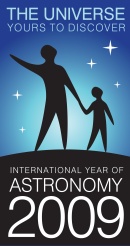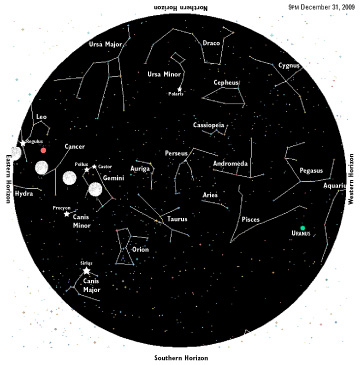Chesapeake Bay's Independent Newspaper ~ Since 1993
1629 Forest Drive, Annapolis, MD 21403 ~ 410-626-9888
Volume XVII, Issue 53 ~ December 31, 2009 - January 6, 2010
Home \\ Correspondence \\ from the Editor \\ Submit a Letter \\ Classifieds \\ Contact Us
Dining Guide \\ Home & Garden Guide \\ Archives \\ Distribution Locations \\ Advertising
![]()



Sky Watch

by J. Alex Knoll
91 Million Miles from the Sun
While we’re closest to Old Sol, these long days are still cold
Thursday’s full moon illuminates the night for New Year’s revelers. And if you’re out gazing toward the heavens, take a moment to get your bearings and maybe even impress your friends. Above the moon are the Gemini twins Castor and Pollux. Farther to the east is ruddy Mars, trailed by Regulus, the heart of Leo the lion. Below the moon is Procyon, the little dog, while much lower the big dog Sirius, brightest of stars, blazes against the cold. Above Sirius you can’t miss the familiar outline of Orion.
While winter’s grip on us tightens as the weather grows colder, two astronomical happenings this week might warm your thoughts if not your hands.
First, earth reaches perihelion, its closest point to the sun, Saturday, January 2. While the cold may have you thinking we’re as far from the sun as can be, we are, in fact, 3 million miles closer than we were six months ago. Still, that’s not even a five percent difference, not near enough to offset the far fewer hours of daylight we’re enjoying. And that’s what it takes to truly warm our hemisphere.
More immediately, Tuesday marks a turning point against the dark, as it is the latest sunrise of the year, when Old Sol doesn’t crest the east horizon until 7:25:13. We’ve already experienced the earliest sunset of the year nearly a month ago, and now we’ll be gaining a little daylight in both the morning and evening. Even so, it’s a slow haul: We’re gaining mere seconds of light each morning, so that by the end of January the sun will rise only 12 minutes earlier than this Tuesday.
If you’re out before sunrise the morning of the 4th, look to the east toward the constellation Boötes for any streaking lights from the Quandrantid meteor shower. With a moon just past full, these aren’t great conditions, but you may still spot a dozen or so in any given hour.
Illustration: © Copyright 1925 M.C. Escher/Cordon Art-Baarn-Holland; Graphics: © Copyright 2009 Pacific Publishers. Reprinted by permission from the Tidelog graphic almanac. Bound copies of the annual Tidelog for Chesapeake Bay are $14.95 ppd. from Pacific Publishers, Box 480, Bolinas, CA 94924. Phone 415-868-2909. Weather affects tides. This information is believed to be reliable but no guarantee of accuracy is made by Bay Weekly or Pacific Publishers. The actual layout of Tidelog differs from that used in Bay Weekly. Tidelog graphics are repositioned to reflect Bay Weekly’s distribution cycle.Tides are based on National Oceanic and Atmospheric Administration and are positioned to coincide with high and low tides of Tidelog.
© COPYRIGHT 2009 by New Bay Enterprises, Inc. All rights reserved.
